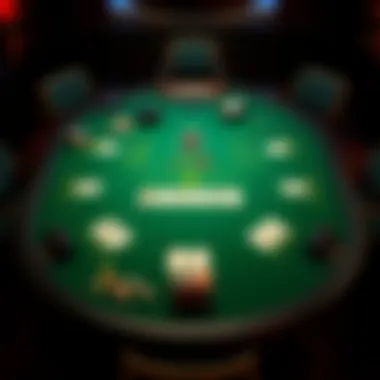Mastering Spanish 21: Rules and Strategies Explained


Intro
Spanish 21 can be an appealing variant of traditional blackjack for many players. Its distinct twist on the original game offers a refreshing change, especially for those looking to up their betting game. There's a kind of charm found within the unique rules of Spanish 21, making the game so different that it often feels like an entirely new experience. Before diving into strategies and betting techniques, it's crucial to grasp the essentials of the game itself, as that knowledge forms the foundation for every move you make.
Betting Strategies
When it comes to excelling in Spanish 21, understanding betting strategies is paramount. Various factors come into play here that distinguish this game from standard blackjack.
Understanding Odds and Payouts
In Spanish 21, players enjoy some enticing payouts that traditional blackjack doesn't offer. The game pays 3:2 on natural blackjacks, but it also provides the opportunity for players to take advantage of unique bonuses on specific hands. Understanding the odds at play can significantly influence your betting patterns.
One key feature to notice is the removal of the 10s from the deck, which alters probabilities in fundamental ways. For instance, the odds of getting a blackjack are affected. Instead of the usual 4 possible ten-count cards, Spanish 21 only has 2s, 3s, 4s, and so on, changing your strategy considerably.
When evaluating your bets, mindful measures regarding the dealer's face-up card are essential, as different cards signal various risks and rewards.
Advanced Betting Techniques
Moving beyond the fundamentals, let's discuss some advanced betting techniques that can give you a sharper edge at the table. One method that experienced players often employ is the "Martingale System". This means doubling your bet after each loss to recover losses after a win eventually.
Keep in mind:
- This technique requires a hefty bankroll.
- You can reach the table's betting limits quickly.
Another approach might include the concept of 'betting progression.' This involves increasing your bets after a win while decreasing them after a loss. This strategy can minimize losses during unfortunate hands but requires discipline and a keen understanding of your typical playing style and risk tolerance.
Tips for Strategic Play
To truly excel, players need to cultivate not only their knowledge of rules but also a mental approach to the game. Emotional control can mark the difference between winners and losers. Being mindful of when to walk away is a skill often overlooked.
Ultimately, Spanish 21 is less about sheer luck and more about strategic play and execution. This captivating game invites players to engage deeply, understand nuances, and develop a personalized style adaptable to various scenarios.
By continually improving your understanding of odds, payouts, and sophisticated betting strategies, anyone can step into the world of Spanish 21 with confidence.
"In every hand, there lies the potential for both victory and defeat; it's all in how you play your cards."
For further reading on this topic, you can explore resources on Wikipedia here: Spanish 21.
Additionally, discussions on forums like Reddit can provide a vibrant community of insights: Reddit Gambling
Stay tuned for more details on additional strategies, psychological elements, and the enthralling experience Spanish 21 has to offer.
Foreword to Spanish
Spanish 21 is not just another card game; it’s a nuanced twist on the traditional blackjack that beckons players with its unique offerings. Understanding this game is essential for anyone who yearns to master the art of gambling, as it introduces several rule variations and strategic depths that can significantly shift the odds in a player's favor.
Familiarity with the gameplay and its particularities can give players a substantial edge over the house, particularly in a setting where quick decision-making is paramount. Unlike classic blackjack, where players are often at the mercy of strict rules, Spanish 21 invites innovation in strategy. With more flexibility in play and an intricate set of rules that includes the potential for enhanced payouts, players are encouraged to think critically and adaptively.
This introduction serves to lay the groundwork for what’s to follow. By diving into specific elements that shape Spanish 21, readers will not only gain clarity on the game itself but will also be better prepared to engage with advanced concepts explored later in the guide. The beauty of Spanish 21 lies not only in its playability but also in its rich history and evolution, which are both fascinating and integral to understanding its current standing in the gambling world.
What is Spanish ?
Spanish 21, sometimes referred to simply as "Spanish," is a variant of blackjack that employs a unique deck and set of rules. The most striking aspect of Spanish 21 is its use of a Spanish deck, which omits all the 10s, leaving 48 cards in total. This alteration not only alters card counting but also modifies player strategies.
The objective remains similar to blackjack: beat the dealer's hand without exceeding 21. However, the gameplay incorporates several bonuses and special rules that enhance player engagement and potential winnings. For example, players can take advantage of specific payouts for certain hands, such as 21 made with five or more cards, a dynamic that can turn a standard game into an exhilarating experience.
One notable aspect of the game is its structure of players being allowed to double down not just after the initial two cards but also after splitting pairs. This strategic opportunity can lead players to accumulate wins that could significantly surpass traditional blackjack payouts.
History and Evolution of the Game


The origins of Spanish 21 can be traced back to the early 1990s when it was designed to attract more players looking for an enticing variant of the classic blackjack. The game's inception took place primarily in the casinos of late 20th century, especially within regions where traditional blackjack dominated the gambling charts.
As casinos sought ways to draw in crowds, Spanish 21 emerged, blending familiar blackjack elements with fresh twists to create a more engaging experience. Its popularity burgeoned quickly, especially in areas with higher concentrations of Spanish-speaking communities, who were often more accustomed to its card structure. Over the years, the game has seen various adaptations, including important rule changes aimed at boosting player options and increasing potential strategies.
Today, Spanish 21 has carved its niche in both land-based and online casinos. It attracts players not only for its diverse set of rules but also for its engrossing pace and the challenge it presents compared to its predecessor. Players find themselves increasingly turning toward Spanish 21, eager to engage in its complexities while enjoying the thrill of modern gambling.
Basic Rules of Spanish
Understanding the basic rules of Spanish 21 is crucial for anyone looking to excel in this captivating game. While at first glance, Spanish 21 may appear similar to classic blackjack, the nuances in its regulations define the gameplay, strategies, and ultimately, the potential for winning. Grasping these essentials can significantly impact a player’s experience, offering an edge that could distinguish a casual player from a seasoned gambler.
Games Setup and Objective
Spanish 21 is generally played with six or eight decks of cards. Unlike classic blackjack, the game excludes all 10s from the decks, which gives it a unique twist. This change significantly shifts the odds in favor of the house, making understanding the objective even more paramount.
The main goal in Spanish 21 mirrors that of traditional blackjack: to beat the dealer. Players aim to attain a hand value of 21 or as close to it as possible without exceeding it. Players win either by having a higher total than the dealer or if the dealer busts after exceeding 21. The additional complexity arises from the special rules surrounding specific hands and strategies to adopt according to the cards shown.
Card Values and Gameplay Mechanics
In Spanish 21, card values operate similarly to blackjack, with some notable exceptions. Number cards from 2 to 9 hold their face value, while both face cards (kings, queens, and jacks) and aces follow suit in value. However, without the 10s, the remaining card composition leads to unexpected gameplay dynamics.
Players are dealt two cards, and can choose to hit, stand, double down, or split if they have a pair. A standout aspect of Spanish 21 is the ability to re-split aces and double down after splitting, providing additional opportunities for maximizing wins. Furthermore, some variations allow for surrendering a hand, letting you forfeit half your bet if you feel your chances are poor. Each of these elements influences the fundamental strategy a player must adopt. Understanding how these mechanics interrelate is key to refining your approach in the game.
Betting Options
Betting in Spanish 21 offers a variety of options that can enhance both the excitement and strategic approach. Players begin by placing a wager before cards are dealt, but several additional opportunities arise throughout the game. For instance, insurance is typically available if the dealer has an ace showing, offering a side bet against the dealer's potential blackjack.
In addition to standard wagers, players often have the option to make bonus bets, which can sometimes include betting on achieving a particular hand or combination of cards. As with many casino games, understanding the potential payouts for each bet is critical. The house edge may vary depending on the specific rules of the casino and the structure of the bets. Knowing when and how to maximize potential returns can be the difference between a successful session and a poor outing at the table.
"Mastering Spanish 21 begins with a solid grasp of its foundational rules, which sets the stage for strategic play and informed betting choices."
In summary, the basic rules of Spanish 21 aren’t just foundational—they are the pillars upon which successful strategies are built. For new players, taking the time to thoroughly understand these aspects can pay dividends down the line, allowing for a more engaging and potentially profitable gaming experience.
Key Differences from Classic Blackjack
Understanding the contrasts between Spanish 21 and classic blackjack is fundamental for anyone looking to enhance their gameplay. These differences aren't just trivial details; they can significantly affect your odds and strategies at the table. Familiarity with the unique elements of Spanish 21 can empower players to adjust their approach and potentially improve their results.
Deck Composition
One of the most notable differences lies in the deck composition. In Spanish 21, all tens are removed from the deck, meaning that instead of the usual 52 cards, you’re actually playing with 48 cards. This alteration serves as a double-edged sword. On one hand, it increases the likelihood of multiple aces and face cards appearing, which can be beneficial for those skilled in card counting. On the other hand, the absence of tens lowers the total number of possible combinations for achieving a total of 21.
Players accustomed to classic blackjack need to reconfigure their strategies since the chance to hit for 20 becomes less predictable. Here, drawing an ace and a face card won’t yield the same results, necessitating a keen eye on the odds and the value of reaching totals like 19 which suddenly hold more weight in scoring.
Payout Structure Variations
The payout structure in Spanish 21 also deviates from the conventional rules of blackjack. In classic blackjack, a natural 21 typically pays 3:2, a favorite among players. In contrast, Spanish 21 frequently offers a more varied payout system. If a player holds a 21 made up of an ace with two face cards, they're often rewarded with a bonus payout, often 2:1.
Additionally, other combinations leading to 21 can yield different payouts, thus propelling the excitement of the game. This distinct structure shifts the dynamics and can influence tactics. Players must weigh the potential rewards against their hand—risking a little more in hopes of securing a substantial payout can be a nail-biting yet thrilling gamble.
Rule Variations That Impact Strategy
Lastly, Spanish 21 introduces a range of rule variations that significantly impact strategy. For instance, players benefit from the option to re-split aces, which is generally not allowed in classic blackjack. This extra flexibility can lead to more aggressive strategies, enabling players to maximize their opportunities for high scoring.
Moreover, the game allows for a surrender option after a player splits, which can be a saving grace on a poor hand. Knowing when to fold can often make or break a game; thus, understanding these specifics is crucial for implementing an effective strategy.
"The game is not just about the cards you hold but also about how well you understand your options and the table dynamics."
In essence, these differences with classic blackjack shape a unique playing experience for Spanish 21. Savvy gamers can leverage this knowledge to craft strategies that enhance their opportunities at winning, while novices will find that adapting to these nuances can set the stage for more confident play.
Strategic Approaches to Spanish


Strategic approaches to Spanish 21 are really crucial for players looking to up their game. The distinct rules and variations in Spanish 21, compared to the traditional blackjack, provide numerous ways to exploit potential advantages. This is not just a game of luck; strategy plays a major role in determining success at the table. Knowledge in strategic play helps players minimize losses and maximize gains, leading to an enriched gaming experience.
A well-rounded strategy incorporates multiple elements, from basic play techniques to more advanced methods. By combining these strategies, players can enhance their overall edge in the game. Therefore, it is fundamental to grasp the core approaches that drive decision-making in Spanish 21.
Basic Strategy Charts
Basic strategy charts serve as incredibly useful tools for players of all levels. These charts outline the optimal plays one should make based on the player's hand and the dealer's upcard. With Spanish 21 having unique rules, traditional blackjack strategy charts may not always translate effectively.
Some notable points about basic strategy charts include:
- Player's Hand vs. Dealer's Upcard: The chart guides you on whether to hit, stand, double down, or surrender depending on the cards in play.
- Reference at the Table: Keeping a chart handy can help experienced and novice players alike remain disciplined in their decision-making.
- Practice Makes Perfect: Before hitting the casino, practicing with these charts can solidify decision-making processes during actual gameplay.
Players may even create custom charts that factor in additional rules specific to the house they are playing at. Regularly reviewing these strategies enhances comprehension and builds confidence.
Card Counting Techniques
Card counting is often viewed as the holy grail of casino strategies, and it holds true for Spanish 21 as well. By tracking the high and low cards still left in the deck, players can adjust their bets more strategically. Understanding this concept can tilt the odds in a player's favor.
Here are some essential techniques:
- Hi-Lo Strategy: This common method assigns point values to specific cards—2 through 6 are +1, 10, J, Q, K, and A are -1, while the cards 7, 8, and 9 have a neutral impact. Keeping a running count allows players to gauge when the remaining cards are more favorable.
- True Count Conversion: To boost effectiveness, divide your running count by the number of decks left in play. This gives a clearer picture of when to increase bets.
- One-Card Advance Counting: In Spanish 21, several important face cards are excluded from play. Knowing what high cards remain could provide a big edge, especially in a game that alters the deck composition.
While card counting requires significant practice, it can lead to substantial rewards at the gaming table. Just be mindful that casinos often watch for counters and may implement countermeasures.
Adjustments Based on Rules
Each casino may have its own set of rules for Spanish 21, and these can significantly affect gameplay. Savvy players should adjust their strategies accordingly. A wise approach is to be adaptable, factoring in these variations into one's gameplay.
Important adjustments include:
- Surrender Options: Not every casino offers surrender, which can alter the strategy employed. If available, knowing when to surrender can save money in the long-run.
- Bonus Payouts: Some casinos may offer bonus payouts for special combinations. Understanding these can encourage riskier plays.
- Level of Deck Penetration: If a dealer penetrates deeper into the deck before shuffling, it could change the probability dynamics. Players should stay alert to this fact and adjust betting strategies accordingly.
Psychology and Player Dynamics
The mental aspect of playing Spanish 21 is often overlooked, yet it plays a critical role in determining the outcome of the game. Understanding psychological factors not only helps players navigate their own emotions and strategies but also equips them with tools to read and respond to their opponents' behavior. Mastering these dynamics can lead to more informed decisions and, ultimately, increased success at the table.
Understanding Opponent Behavior
One key element in gambling is the ability to read the table, especially when playing a game like Spanish 21 where interaction with other players is inevitable. Every player's body language, facial expression, and even their betting patterns can reveal a treasure trove of information that savvy players can exploit.
- Body Language: Look for signals like fidgeting or crossed arms. This could indicate nervousness or confidence, respectively. A player who sits back with composure may have a strong hand, while someone who’s constantly adjusting their seat could be feeling the heat.
- Betting Patterns: Notice when and how much your opponents bet. A player who suddenly increases their wager might be trying to bluff or, conversely, trying to intimidate with a strong hand. Conversely, low bets can indicate caution or uncertainty.
- Responses to Wins or Losses: Observing how players react after winning or losing hands can provide insights into their mentality. Are they celebrating triumphantly or sulking in defeat? A player showing signs of frustration might make riskier decisions as they try to recover losses.
Incorporating these observations into one's gameplay can provide a competitive edge. This level of consciousness creates not just a game of cards, but a mental chess match, where players anticipate and respond to the moves of others.
Managing Emotions at the Table
Emotional control is one of the most significant hurdles faced by many gamblers. In Spanish 21, where fast-paced decisions can lead to shifts in fortune, maintaining composure is paramount. Here are several strategies to help with emotional management during play:
- Breath Control: When tensions run high, take a moment to breathe. Deep breaths can help re-center focus and calm anxiety, especially before making big bets or decisions.
- Stay Objective: It’s easy to get swept up in the excitement or disappointment of the game. Try to stick to your strategic plan and not get carried away by emotions. Setting win/loss limits before starting can help frame your gameplay.
- Physical Stance: Maintain a relaxed posture. Tension in your body can lead to a tense mindset, which could interfere with rational decision making.
A calm approach allows for clearer thinking and better hand evaluation. Sometimes it’s better to sit out for a round or two if emotions are running high. It’s important to recognize when it’s time to take a step back, gather your thoughts, and return to the table with a clearer mind.
"The greatest weapon against stress is our ability to choose one thought over another." - William James
In essence, mixing a keen eye on opponents with emotional regulation contributes to a highly effective strategy in Spanish 21. By focusing on both these dynamics, players can sharpen their instincts and enhance their gameplay, leading to a richer experience overall.
Advanced Strategies for Experienced Players


As one dives deeper into the world of Spanish 21, the importance of honing advanced strategies cannot be overstated for seasoned players. While the foundational rules provide a solid base for play, understanding the nuances of strategy can greatly enhance one's chances of success at the table. Advanced strategies encompass a variety of elements, from game theory applications to considerations for high-rollers. These strategies offer not merely a pathway to victory but also add a layer of depth to the gambling experience that can be both intellectually stimulating and financially rewarding.
Game Theory Applications
When approaching Spanish 21 with a mindset grounded in game theory, players begin to understand the decisions at hand as part of a larger strategic framework. Game theory provides insights into the interactions between players and the dealer. For instance, your choices may not only impact your own outcome but also influence your opponents’ strategies.
It’s essential to recognize situations where bluffing or aggressive play can shift the balance of the game in your favor. By understanding the probabilities involved, you can make decisions based on expected value rather than simple impulse. This could mean choosing to hit when the deck is rich with tens and face cards, leveraging the increased likelihood of achieving a winning total.
Some key aspects to keep in mind when applying game theory include:
- Payoff Matrix: Consider the potential outcomes of your moves. Is it worth risking a large bet on a hand that has a low probability of winning?
- Nash Equilibrium: Recognize your opponents' potential reactions to your moves and adjust accordingly. It’s like a cat-and-mouse game where predicting their actions can put you ahead.
- Mixed Strategies: Sometimes, it’s beneficial to mix up your betting patterns. This unpredictability can throw off your opponents who depend on reading your tendencies.
"In the world of Spanish 21, the mind is as much a weapon as the cards in your hand."
High-Roller Considerations
For those who venture into the realm of high-stakes play, understanding the unique considerations for high-rollers in Spanish 21 is crucial. Betting larger amounts introduces a different dynamic into the game, where the stakes are not just financial but emotional and psychological too. In these situations, being armed with advanced strategies can pay off significantly.
High-rollers often have to deal with:
- Table Dynamics: The atmosphere can shift dramatically at high-stakes tables. The pressure mounts not just due to the amounts involved but also because players may face more experienced opponents who aren't shy about their tactics.
- Bankroll Management: A savvy high-roller understands how to manage their bankroll with precision. Setting strict limits on losses and wins can prevent the emotional rollercoaster that often accompanies large stakes.
- Playing Styles: At higher levels, the need to adjust one's style based on the collective skill of the table becomes paramount. Adopting a more aggressive approach might work against novices but could be ill-advised with a table of skilled players.
In essence, navigating the world of Spanish 21 as an experienced player entails a careful balance of physical gameplay and mental strategies. Mastery comes from understanding that every decision, every bet, and every read on an opponent counts in this captivating mix of chance and skill.
Online vs. Offline Play
In the landscape of Spanish 21, the choice between playing online and offline has profound implications for the player's experience. Each mode has its own set of merits and drawbacks that cater to different styles and preferences. Understanding these can significantly enhance one’s strategy and enjoyment of the game.
Advantages of Online Platforms
Online Spanish 21 offers several advantages that streamline gameplay and expand accessibility. Here are a few standout benefits:
- Convenience: Players can jump into a game from the comforts of their home, any time of day, without having to travel to a casino. This eliminates travel time and expenses, enabling more time to enjoy the game.
- Variety: Online platforms often present a wider variety of games and variations, facilitating an exploration of different rule sets and betting formats. Players can easily switch between tables with different styles or versions of Spanish 21.
- Promotions and Bonuses: Many online casinos tempt new players with generous welcome bonuses, free bets, or cash prizes that can significantly enhance the bank. These offers can provide an edge, especially for those who are looking to maximize their bankroll.
- Practice Opportunities: For those new to Spanish 21, online options frequently include free play modes, allowing players to practice without the sting of losing real money. This is an excellent way to get accustomed to the game’s mechanics before risking funds.
Yet, as appealing as it may seem, online play also comes with its own set of challenges. Internet connection issues, for instance, can interrupt the flow of the game, and some may find it hard to replicate the adrenaline rush that comes with live play.
Social Aspects of Live Casinos
Conversely, the charm of offline play lies in its social dynamics and atmosphere, which can profoundly shape one’s gaming experience. Here’s what makes live casinos compelling:
- Player Interaction: Engaging with other players and dealers creates a shared experience that can heighten the excitement of gameplay. Whether it’s sharing strategy tips or celebrating wins together, the camaraderie can be uplifting.
- Physical Presence: For many, the thrill of handling cards and chips physically, and the sound of shuffling and spinning, adds an essential layer to the game. This tactile element contributes to a more immersive experience.
- Atmosphere: The ambiance of a bustling casino — with its lights, sounds, and energy — can be intoxicating. This environment fosters a sense of occasion that online venues often struggle to replicate.
- Reading Opponents: Offline play allows for non-verbal cues and body language to come into play. Observing opponent behaviors can provide insights and signals that inform betting strategies, something that is often absent in the online setting.
In summary, whether one leans towards online or offline play largely hinges upon personal preference, goals, and gaming style. While online platforms may allure with accessibility and convenience, the community and atmosphere of live casinos remain unmatched. Each method offers unique advantages and entertaining challenges for those eager to dive deeper into the world of Spanish 21.
Key Takeaway: Ultimately, both online and offline options hold promise for Spanish 21 enthusiasts — it’s about finding the habitat that suits your playing style and preference best.
Epilogue: Mastering Spanish
In the realm of gambling, Spanish 21 stands out as a captivating experience, merging strategy with the thrill of chance. As this guide has demonstrated, mastery over this variant of blackjack extends beyond mere familiarity with rules; it encompasses a nuanced understanding of psychological dynamics, strategic depth, and continual growth as a player. To truly excel requires forming a mindset geared toward precision and adaptability.
Building a Winning Mindset
When approaching Spanish 21, possessing a winner's mentality is crucial. This means more than just aiming to be on the winning side of the dealer. It entails a comprehensive grasp of the game's strategies, as well as an approach that values patience and discipline. You must develop the ability to read situations carefully, knowing when to push your luck and when to hold back. A successful player often refers to this cadence as finding their own rhythm at the table.
- Focus on Your Strategy: Ensure you know the basic strategies inside and out, treating them as the core of your gameplay. This foundation will determine your agility in adapting to different situations.
- Stay Calm Under Pressure: Emotions can run high during striking moments, but keeping a level head allows for better decision-making. Those who learn to manage their feelings often find they can outplay even experienced opponents who succumb to frustration.
- Visualization Techniques: Many top players use visualization to rehearse gameplay scenarios, which prepares them mentally for real situations when they arise. Imagine hitting a 21, envision the dealer busting, and play these scenarios out in your mind.
"Success is where preparation and opportunity meet." – Zig Ziglar
Continuous Learning and Adaptation
The world of Spanish 21 is always evolving, and players should adopt a learning attitude that welcomes change. Whether through studying updated strategies, engaging with other players online, or analyzing their own gameplay, continuous improvement is the key to long-term success. Here are a few methods to keep adapting:
- Stay Current with Strategy Resources: Websites such as en.wikipedia.org can offer updates on new rules or variations that may be popping up in gambling circles. Often, integrating knowledge on styling advantages can provide an upper hand.
- Join Online Communities: There's a wealth of knowledge and experience shared in forums like reddit.com. These communities reveal insights on strategies and psychological tactics that you might not find in books or articles.
- Record and Reflect on Your Play: Keeping a gaming journal might seem tedious, but it can pay off. Note down past games, outcomes, and emotions. Over time, patterns emerge that can offer invaluable lessons for future gameplay.
Ultimately, mastering Spanish 21 isn’t a destination but a journey. Every hand dealt, every decision made, and every feeling experienced contributes to a growing tapestry of expertise. Embrace the intricacies, commit to learning, and cultivate a steady mindset. The table might be just a stretch of felt, but the stakes? They’re as real as it gets.















